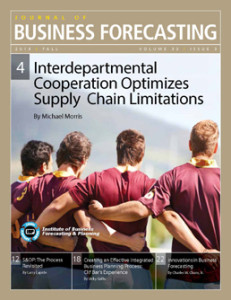Click here to download a sample copy of the latest Journal of Business Forecasting (JBF)
Click here to Become an IBF member and get a JBF subscription FREE
Featured Articles:
Interdepartmental Cooperation Optimizes Supply Chain Limitations
By Michael Morris
The author describes how working with Marketing and Sales helps manage the constraints in the supply chain while meeting customer requirements and maintaining profitability.
Is Communication More Important Than Accuracy in Demand Planning?
By John Gallucci
Demand Planning performance is driven by metrics. MAPE and bias provide a compass to evaluate performance, and make necessary changes to the forecast. It is for this reason that most Demand Planning teams put a significant amount of emphasis on delivering improvements against these objectives, and why industry benchmarking reports focus in this area. In this article, I explore whether metrics alone can truly drive the business results that most executive leaders are looking for. I share some experience that highlights the importance of communicating the context surrounds a forecast. It is highly plausible that synergizing performance metrics with the right communication strategy creates a formula that unlocks enhanced supply chain results.
S&OP: The Process Revisited
By Larry Lapide
This column discusses Sales and Operations Planning (S&OP) “foundational” success factors. A list of ten process-related factors is presented for managers to use to gauge whether or not an S&OP process is healthy enough to have a long and productive life. In addition, a process deficient in one or more factors may render it unsound when attempting to implement various process and technology advancements upon it.
Creating an Effective Integrated Business Planning Process: Clif Bar’s Experience
By Vicky Grillo
S&OP is a great process to manage demand. In this article, the author shows how Clif Bar, producer of organic foods and drinks, implemented this process with great success.
Innovations in Business Forecasting
By Charles W. Chase, Jr.
When it comes to new product forecasts, some executives would say that it is a frustrating and futile effort due to the lack of data (or minimal data), limited analysis capabilities, and a general uncertainty surrounding a new product launch, not to mention the ever changing and fickle marketplace. A structured analogy approach can be useful in many situations, but certainly not in all new product forecasting efforts. A new “Structured Judgment” approach attempts to improve on human judgment alone by automating the historical data handling and incorporating statistical analysis. However, judgment (domain knowledge) needs assistance to keep the process on track and as objective as possible. The real innovation is in combining structured data with unstructured data using “Sentiment Analysis.”
Fading Growth Acceleration for the Rest of the Year
By Evangelos Otto Simos
Dr. Simos is Director of Forecasting and Predictive Analytics at e-forecasting.com, a division of Infometrica’s Data Center and professor of economics at Paul College, University of New Hampshire. This report does not purport to be a complete description of global economic conditions and financial markets. Neither the Journal nor Infometrica, Inc. guarantee the accuracy of the projections, nor do they warrant in any way that the use of information or data appearing herein will enhance operational or investment performance of individuals or companies who use it. The views presented here are those of the author, and in no way represent the views, analysis, or models of Infometrica, Inc. and any organization that the author may be associated with.
The U.S. Economic Growth: Steady but Still below Potential Pace Growth
By Jamal Nahavandi
Dr. Nahavandi is Associate Professor of economics at Pfeiffer University School of Graduate Studies, specializing in Business Economics, International Business, and Healthcare Economics. The information in this forecast is gathered by the Journal from sources it considers reliable. Neither the Journal nor the individual institutions providing the data guarantee accuracy; nor do any of them warrant in any way that use of the data appearing herein will enhance the business or investment performance of companies or individuals who use them.
Answers to Your Forecasting Questions
By Chaman L. Jain
The Journal of Business Forecasting has been providing demand planning, forecasting, supply chain, and S&OP practitioners with jargon-free articles on how to improve the value of their roles and company performance from improved forecasting and planning for over 30 years. A subscription to the JBF comes with IBF membership at no additional cost.



